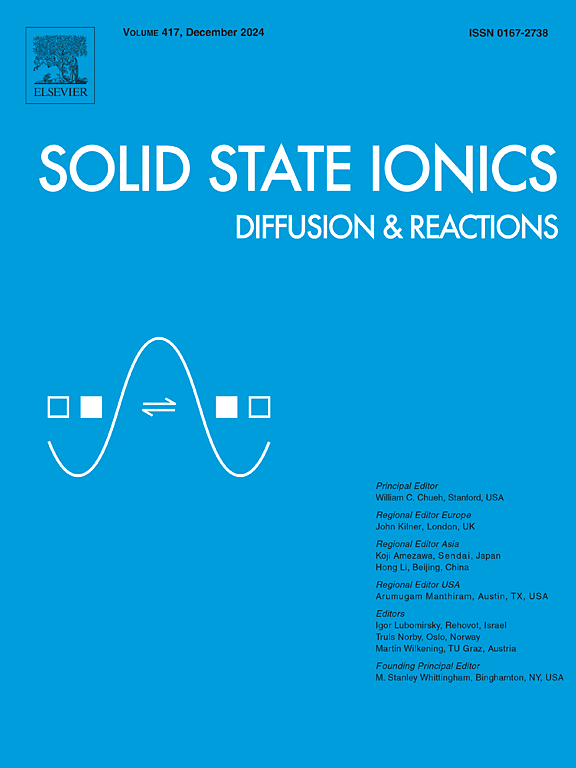High concentrations of sodium dodecylbenzene sulfonate electrolyte additives improve the performance of aqueous zinc ion batteries
IF 3
4区 材料科学
Q3 CHEMISTRY, PHYSICAL
引用次数: 0
Abstract
In aqueous zinc-ion batteries (AZIBs), traditional electrolytes are unable to fully utilise the potential of the zinc anode due to severe dendrite growth and side reactions on the zinc metal anode. Therefore, this study adds a high concentration of sodium dodecyl benzenesulfonate (SDBS) to the electrolyte to achieve the dual purpose of regulating the zinc deposition process and protecting the zinc substrate. The formation of large micelles induced by SDBS plays a stabilizing role, reduces fluctuations in the electrolyte, and enhances the orderly transfer of Zn2+, thereby increasing the amount of ion transfer. Furthermore, SDBS adsorbed on the zinc anode surface improves surface wettability, accelerates the three-dimensional diffusion process and guides Zn2+ to form a uniform flaky deposited layer. Additionally, the addition of SDBS effectively replaces the water-rich electric double layer (EDL) on the zinc surface with SDB−, significantly mitigating the harmful effects of H2O on the anode. High-concentration SDBS therefore exhibits excellent performance in symmetrical batteries (over 2000 h at 0.8 mA cm−2, 0.8 mAh cm−2). This study found that with the addition of a high concentration of surfactant, Zn2+ has a rapid three-dimensional diffusion process and horizontal deposition behavior, which is instructive for exploring ion transfer in high-concentration electrolyte additives.

高浓度的十二烷基苯磺酸钠电解质添加剂提高了水性锌离子电池的性能
在含水锌离子电池(azib)中,由于锌金属阳极上严重的枝晶生长和副反应,传统电解质无法充分利用锌阳极的潜力。因此,本研究在电解液中加入高浓度的十二烷基苯磺酸钠(SDBS),以达到调节锌沉积过程和保护锌基体的双重目的。SDBS诱导形成的大胶束起到了稳定作用,减少了电解质的波动,增强了Zn2+的有序转移,从而增加了离子转移量。吸附在锌阳极表面的SDBS提高了锌阳极表面的润湿性,加速了锌阳极的三维扩散过程,引导Zn2+形成均匀的片状沉积层。此外,SDB -的加入有效地取代了锌表面的富水双电层(EDL),显著减轻了H2O对阳极的有害影响。因此,高浓度SDBS在对称电池中表现出优异的性能(在0.8 mA cm - 2和0.8 mAh cm - 2下超过2000小时)。本研究发现,在高浓度表面活性剂的加入下,Zn2+具有快速的三维扩散过程和水平沉积行为,这对探索高浓度电解质添加剂中的离子转移具有指导意义。
本文章由计算机程序翻译,如有差异,请以英文原文为准。
求助全文
约1分钟内获得全文
求助全文
来源期刊

Solid State Ionics
物理-物理:凝聚态物理
CiteScore
6.10
自引率
3.10%
发文量
152
审稿时长
58 days
期刊介绍:
This interdisciplinary journal is devoted to the physics, chemistry and materials science of diffusion, mass transport, and reactivity of solids. The major part of each issue is devoted to articles on:
(i) physics and chemistry of defects in solids;
(ii) reactions in and on solids, e.g. intercalation, corrosion, oxidation, sintering;
(iii) ion transport measurements, mechanisms and theory;
(iv) solid state electrochemistry;
(v) ionically-electronically mixed conducting solids.
Related technological applications are also included, provided their characteristics are interpreted in terms of the basic solid state properties.
Review papers and relevant symposium proceedings are welcome.
 求助内容:
求助内容: 应助结果提醒方式:
应助结果提醒方式:


